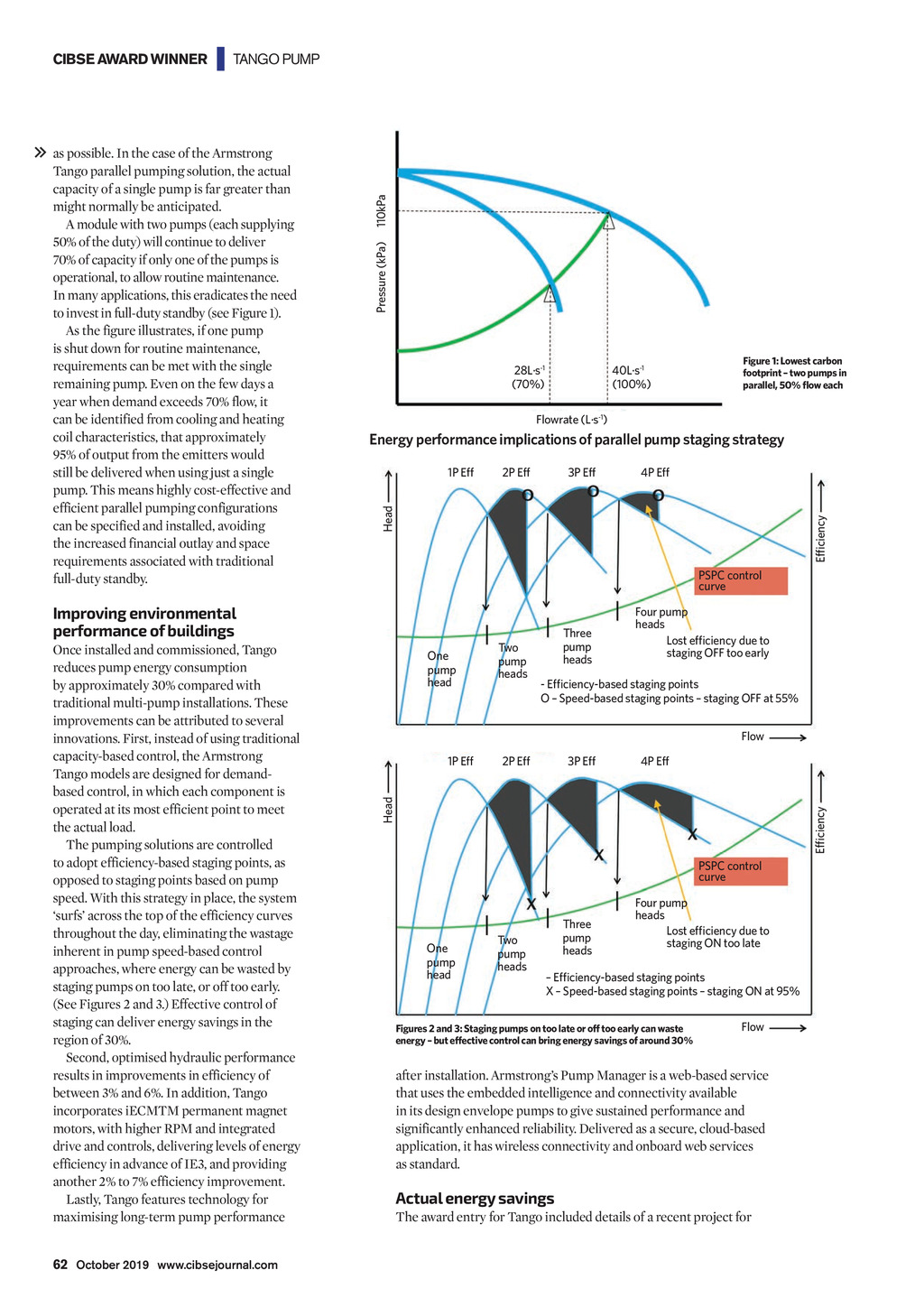




Pressure (kPa) 28L.s-1 (70%) Figure 1: Lowest carbon footprint two pumps in parallel 0 flow each Flowrate (L.s-1) Energy performance implications of parallel pump staging strategy 1P Eff 2P Eff 3P Eff 4P Eff PSPC control curve Improving environmental performance of buildings ne pump head Two pump heads Three pump heads Four pump heads Lost efficiency due to staging FF too early - Efficiency-based staging points Speed-based staging points staging FF at 55% Flow 1P Eff 2P Eff 3P Eff 4P Eff Efficiency Head Once installed and commissioned, Tango reduces pump energy consumption by approximately 30% compared with traditional multi-pump installations. These improvements can be attributed to several innovations. First, instead of using traditional capacity-based control, the Armstrong Tango models are designed for demandbased control, in which each component is operated at its most efficient point to meet the actual load. The pumping solutions are controlled to adopt efficiency-based staging points, as opposed to staging points based on pump speed. With this strategy in place, the system surfs across the top of the efficiency curves throughout the day, eliminating the wastage inherent in pump speed-based control approaches, where energy can be wasted by staging pumps on too late, or off too early. (See Figures 2 and 3.) Effective control of staging can deliver energy savings in the region of 30%. Second, optimised hydraulic performance results in improvements in efficiency of between 3% and 6%. In addition, Tango incorporates iECMTM permanent magnet motors, with higher RPM and integrated drive and controls, delivering levels of energy efficiency in advance of IE3, and providing another 2% to 7% efficiency improvement. Lastly, Tango features technology for maximising long-term pump performance 40L.s-1 (100%) Efficiency as possible. In the case of the Armstrong Tango parallel pumping solution, the actual capacity of a single pump is far greater than might normally be anticipated. A module with two pumps (each supplying 50% of the duty) will continue to deliver 70% of capacity if only one of the pumps is operational, to allow routine maintenance. In many applications, this eradicates the need to invest in full-duty standby (see Figure 1). As the figure illustrates, if one pump is shut down for routine maintenance, requirements can be met with the single remaining pump. Even on the few days a year when demand exceeds 70% flow, it can be identified from cooling and heating coil characteristics, that approximately 95% of output from the emitters would still be delivered when using just a single pump. This means highly cost-effective and efficient parallel pumping configurations can be specified and installed, avoiding the increased financial outlay and space requirements associated with traditional full-duty standby. 110kPa | TANGO PUMP Head CIBSE AWARD WINNER PSPC control curve ne pump head Two pump heads Three pump heads Four pump heads Lost efficiency due to staging N too late Efficiency-based staging points X Speed-based staging points staging N at 95% Figures 2 and 3: Staging pumps on too late or off too early can waste energy but effective control can bring energy savings of around 30% Flow after installation. Armstrongs Pump Manager is a web-based service that uses the embedded intelligence and connectivity available in its design envelope pumps to give sustained performance and significantly enhanced reliability. Delivered as a secure, cloud-based application, it has wireless connectivity and onboard web services as standard. Actual energy savings The award entry for Tango included details of a recent project for 62 October 2019 www.cibsejournal.com CIBSE Oct19 pp61-63 Armstrong pump.indd 62 20/09/2019 18:19